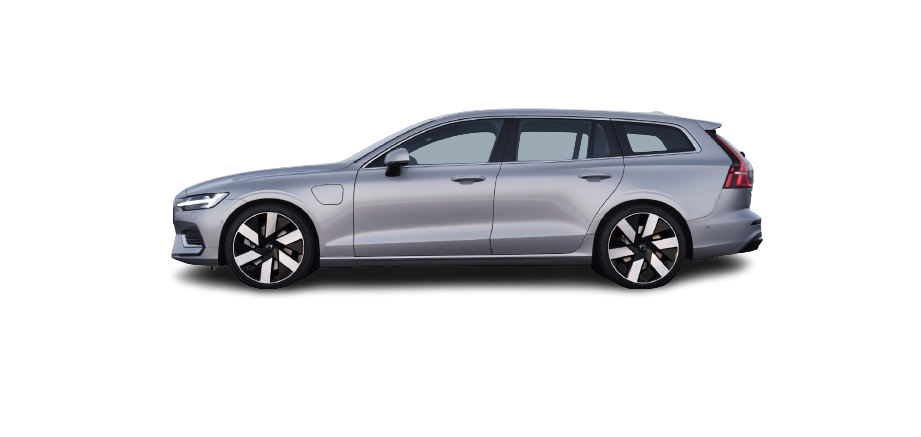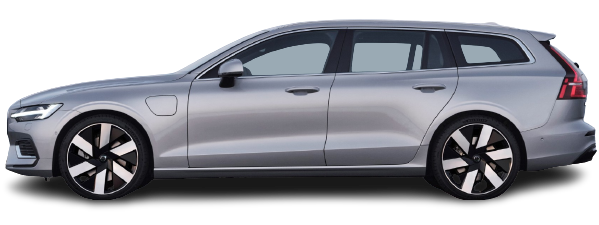Steering wheel and instrument panel
- Position lamps, daytime running lights, dipped beam, main beam, direction indicators, front fog lamps/cornering lights, rear fog lamp, resetting the trip meter
- Head-up display
- Driver display
- Wipers and washing, rain sensor
- Right-hand steering wheel keypad
- Steering wheel adjustment
- Hor
- Left-hand steering wheel keypad
- Bonnet opening
- Unlocking/opening/closing the tailgate
Roof console
- Panoramic roof
- Front reading lamps and interior lighting
- Display in roof console, button
- Flap for SIM card
- Manual dimming of an interior rearview mirror
Centre and tunnel console
- Centre display
- Hazard warning flashers, defrosting, media
- Gear selector
- Start knob
- Parking brake
- Automatic braking when stationary
Driver’s door
- Memories of power front seat, door mirror, and head-up display settings
- Central lockin
- Power windows, door mirrors, and child locks3
- Adjusting front seat
Displays and controls by the driver in a right-hand-drive car
- Position lamps, daytime running lights, dipped beam, main beam, direction indicators, front fog lamps/cornering lights, rear fog lamp, resetting the trip meter
- Head-up display
- Driver display
- Wipers and washing, rain sensor
- Right-hand steering wheel keypad
- Unlocking/opening/closing the tailgate
- Bonnet opening
- Horn
- Steering wheel adjustment
- Left-hand steering wheel keypad
Roof console
- Panoramic roof
- Front reading lamps and interior lighting
- Display in roof console, button
- Flap for SIM card
- Manual dimming of an interior rearview mirror
Centre and tunnel console
- Centre display
- Hazard warning flashers, defrosting, media
- Gear selector
- Start knob
- Parking brake
- Automatic braking when stationary
Driver’s door
- Memories of power front seat, door mirror, and head-up display settings
- Central locking
- Power windows, door mirrors, electric child lock
- Adjusting front seat
Connection of equipment to the car’s diagnostic socket
Incorrect connection and installation of software or diagnostic tools may have a negative effect on the car’s electronic system.
Volvo strongly recommends that Volvo owners only install Volvo-approved original accessories and that installation of accessories is only carried out by trained and qualified Volvo service technicians. Certain accessories only function when associated software is installed in the car’s computer system.
Note
Volvo Cars accept no liability for the consequences if unauthorized equipment is connected to the On-board Diagnostic socket (OBDII). This socket should only be used by trained and qualified Volvo service technicians.
Driver distraction
Your new Volvo is equipped with content-rich entertainment and communications systems. You may also have other portable electronic devices for your own convenience. Use these systems and devices in a safe manner in order to avoid distraction.
We wish to give the following warnings regarding such systems, to indicate Volvo’s concern for your safety. Never use a device or function in the car in such a way that it will distract you from the task of driving safely. Distractions can lead to serious accidents. Apart from these general warnings, we offer the following advice regarding the new functions that may be in the car:
Warning
- Never use a hand-held mobile phone while driving. In some areas, it is forbidden for the driver to use a mobile phone while the car is moving.
- If the car is equipped with a navigation system you must only set and change the itinerary when the car is parked.
- Never program the audio system while the car is moving. Program the radio’s presets when the car is parked and then use the programmed presets for faster and simpler use of the radio.
- Never use laptops or hand-held computers while the car is moving.
Getting started with Google services
Connect your Google account to your user profile to get started with Google services.
Being logged in with a Google account enables Google services like Google Assistant and Google Maps to be more personalized. To open Google Play, a Google account must be connected to the user profile in question.
Creating a Google account
Go to accounts.google.com/signup. Enter your name, and create or use an existing email and password. Enter your phone number and verify the account using the code sent to the phone.
Logging into the Google account in the center display
- Tap on
- Enter the email address linked to your Google account. Then tap on Next.
- Enter the password linked to your Google account. Then tap on Next.
- If there is a problem logging in, make sure the car is connected to the internet.
Change of market when importing or relocating
If you do not do this then you may experience that apps, Volvo Assistance, software downloads, and other online services are affected and do not work correctly.
If you have already created a Volvo ID in another country and want to use the same email address, you must first delete your Volvo ID in the region you originally created it. Alternatively, you can create a new Volvo ID using another e-mail address.
For cars with Volvo Assistance
Download the Volvo Cars app from the country where the car will be used and link the app to your car.
Note
Visit an authorized Volvo dealer if you have imported or relocated with your car to a new country.
Available services may vary depending on the market and car model.
Note
If the car is exported to another market, Volvo is not responsible for any adaptations to the car in order to comply with requirements or laws that apply in the importing market. Read more in Service and Warranty or contact your Volvo workshop for more information.
Showing the car’s identification number
All cars have a unique identification number, VIN.
Tap on Settings
Continue to System and then About.
Another way of finding VIN is:
- on the first page of the Service and warranty booklet
- in the car’s registration document
- look on the dashboard through the car’s windscreen.
Recording data
The EDR in this vehicle is designed to record data related to the following in the event of traffic accidents or collision-like situations:
- how the various systems in the car worked
- whether the driver and passenger seatbelts were fastened/tensioned
- the driver’s use of the accelerator or brake pedal
- the travel speed of the vehicle.
This information can help us understand the circumstances in which traffic accidents, injuries, and damage occur. The EDR only records data when a non-trivial collision situation occurs. The EDR does not record any data during normal driving conditions. Similarly, the system never registers who is driving the vehicle or the geographic location of the accident or near-miss situation. However, other parties, such as the police, could use the recorded data in combination with the type of personally identifiable information routinely collected after a traffic accident. Special equipment and access to either the vehicle or the EDR are required to be able to interpret the registered data.
In addition to the EDR, the car is equipped with a number of computers designed to continually check and monitor the function of the car. They can record data during normal driving conditions, but in particular register faults affecting the vehicle’s operation and functionality, or upon activation of the vehicle’s driver support function (e.g. City Safety and the auto brake function).
Some of the recorded data is required to enable service and maintenance technicians to diagnose and remedy any faults that occurred in the vehicle. The registered information is also needed to enable Volvo to satisfy legal requirements laid out by in-laws and by government authorities. Information registered in the vehicle is stored in its computers until the vehicle is serviced or repaired.
In addition to the above, the registered information can be used in aggregate form for research and product development with the aim of continuously improving the safety and quality of Volvo cars.
Volvo will not contribute to the above-described information being disclosed to third parties without the vehicle owner’s consent. To comply with national legislation and regulations, Volvo may be forced to disclose information of this nature to the police or other authorities who may assert a legal right to access such. Special technical equipment which Volvo and workshops that have entered into agreements with Volvo have access to is required to be able to read and interpret the recorded data. Volvo is responsible that the information, which is transferred to Volvo during servicing and maintenance, is securely stored and managed and that its management complies with relevant legal requirements. For further information – contact a Volvo retailer.
TCAM
Vehicles equipped with TCAM can collect data on the vehicle’s safety functions as well as other functions in the vehicle. Data are collected for product development, quality follow-up, and safety work, as well as to improve and monitor the vehicle’s quality and its safety functions. The purpose of data collection is also to manage Volvo Car Corporation’s warranty undertakings, as well as to meet legal requirements related to engine emissions data.
Installation of accessories
- Volvo original accessories are tested to ensure that they function with the car systems for performance, safety, and emissions control. In addition, a trained and qualified Volvo service technician knows where accessories may or may not be safely installed in your Volvo. Always seek the advice of a trained and qualified Volvo service technician before installing any accessories in or on your car.
- Accessories that are not approved by Volvo may not have been specifically tested for use with your car.
- Some of the car’s performance or safety systems can be negatively affected if you install accessories that have not been tested by Volvo, or if you permit someone without experience with the car to install accessories.
- Damage that is caused by accessories installed in a non-approved or incorrect way is not covered by any new car warranty. More warranty information can be found in the Service and Warranty Booklet. Volvo does not accept any liability for deaths, personal injury, or costs arising as a result of the installation of non-original accessories.
Important information on accessories and auxiliary equipment
Volvo strongly recommends that Volvo owners only install genuine Volvo-approved accessories and that installation of accessories is only carried out by trained and qualified Volvo service technicians. Certain
accessories only function when associated software is installed in the car’s computer system.
The equipment described in the owner’s manual is not available in all cars – they have different equipment depending on adaptations for the needs of different markets and national or local laws and regulations.
Options or accessories described in this manual are marked with an asterisk. In the event of uncertainty over what is standard or an option/accessory, contact a Volvo dealer.
It is also important that the car has maintenance and service according to Volvo’s recommendations, the owner’s information, and the Service and Warranty Booklet.
If there should be a difference between the information in the center display and the information in other sources, it is always the information in the center display that applies.




